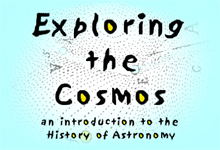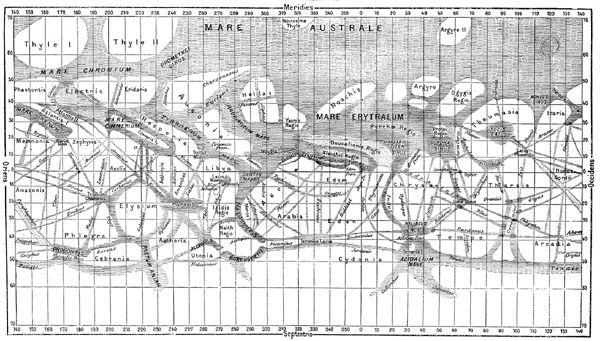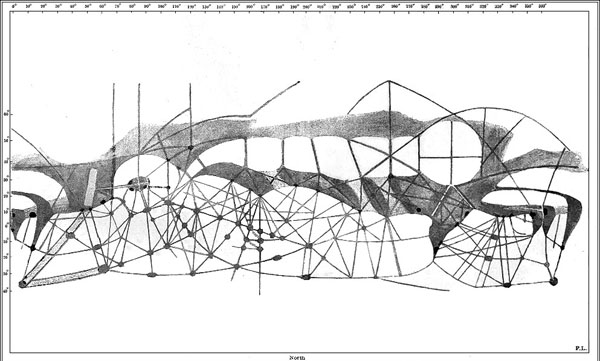

Department of History
University of California, Irvine
Instructor: Dr. Barbara J. Becker
![]()
Week 10. Innovators and Mavericks.
excerpts from
Mars (1895)
by Percival Lowell (1855-1916)
![]()
Who First Saw the Lines?
The first hint the world had of their existence was when [Giovanni Virginio] Schiaparelli [1835-1910] saw some of the lines in 1877.... The world, however, was anything but prepared for the revelation, and, when he announced what he had seen, promptly proceeded to disbelieve him.

Map of Mars, by G. V. Schiaparelli (based on observations made from 1877 to 1886)
Schiaparelli had the misfortune to be ahead of his times, and the yet greater misfortune to remain so; for not only did no one else see the lines at that [time], but no one else succeeded in doing so [later]. For many years fate allowed Schiaparelli to have them all to himself....
In 1879 the canali, as he called them (channels, or canals, the word may be translated...), showed straighter and narrower than they had in 1877: this is not in consequence of any change in them, but from his own improved faculty of detection; for what the eye has once seen it can always see better a second time....
Toward the end of [1879, Schiaparelli] observed one evening what struck him as a most startling phenomenon,--the twinning of one of the canals: two parallel canals suddenly showed where but a single one had showed before. The paralleling was so perfect that he suspected optical illusion. He could, however, discover none by changing his telescopes or eye-pieces. The phenomenon, apparently, was real.
![]()
The Double Canals
Even more markedly unnatural is another phenomenon of this most phenomenal system, of which almost every one has heard, and which almost nobody has seen,--the double canals.
To see them, however, all that is needed is a sufficiently steady air, a sufficiently attentive observer, and the suitable season of the Martian year. When these conditions are observed, the sight may be seen without difficulty, and is ever whit as strange as Schiaparelli, who first saw it, has described it....
So far as the observer is concerned, what occurs is this: Upon a part of the disk where up to that time a single canal has been visible, of a sudden, some night, in place of the single canals he perceives twin canals,--as like, indeed, as twins, if not more so, similar both in character and in inclination, running side by side the whole length of the original canal, usually for upwards of a thousand miles, of the same size throughout, and absolutely parallel to each other. The pair may best be likened to the twin rails of a railroad track. The regularity of the thing is startling.
In good air the phenomenon is quite unmistakable. The two lines are as distinct and as distinctly parallel as possible. No draughtsman could draw them better. They are thoroughly Martian in their mathematical precision. At the very first glance, they convey, like all the other details of the canal system, the appearance of artificiality.
It may be well to state this here definitely, for the benefit of such as, without having seen the canals, indulge in criticism about them. No one who has seen the canals well--and the well is all-important for bringing out the characteristics that give the stamp of artificiality, the straightness and fineness of the lines--would ever have any doubt as to their seeming artificial, however he might choose to blind himself to the consequences.
Exactly what takes place, therefore, in this curious process of doubling, I cannot pretend to say. It has been suggested that a progressive ripening of vegetation from the centre to the edges might cause a broad swath of green to become seemingly two.... Perhaps we may learn considerably more about it at the next [favorable appearance of Mars]. At this tendril end of our knowledge of our neighbor we cannot expect hard wood.
![]()
Now You See Them, Now You Don't!
At times the canals are invisible, and this invisibility is real, not ... an invisibility due to distance or obscuration of any kind between us and them, but an actual invisibility due to the condition of the canal itself. With our present optical means, at certain seasons they cease to exist....
The visible development of the canal system follows the melting of the polar snows....
Having once become visible, these canals remain so, becoming more and more conspicuous as the season advances....
In emerging from invisibility into evidence, the canals first make themselves suspected, rather than seen, as broad, faint streaks smooching the disk. Such effect, however, seems to be an optical illusion, due to poor air and the difficulty inherent in detecting fine detail; for on improvement in the seeing I have observed these broad streaks contract to fine lines, not sensibly different in width from what they eventually become....

Map of Mars by Percival Lowell (1895)
Each canal does not darken all at once, but gradually. We must therefore seek some explanation which accounts for this delay ... namely, that what we see ... is not water, but vegetation.... If, therefore, we suppose what we call a canal to be, not the canal proper, but the vegetation along its banks, the observed phenomena stand accounted for....
We cannot, of course, be sure that such is their character, appearances being often highly deceitful; we can only say that, so far, the supposition best explains what we see.
The growth of the canals consists chiefly in depth of tint. They darken rather than broaden,--a fact which tends to corroborate their vegetal character....
![]()
Intersections
But, singular as each line looks to be by itself, it is the systematic network of the whole that is most amazing. Each line not only goes with wonderful directness from one point to another, but at this latter spot it contrives to meet, exactly, another line which has come with like directness from quite a different direction. Nor do two only manage thus to rendezvous.
Three, four, five, and even seven will similarly fall in on the same spot.... The disk is simply a network of such intersections.... The result is that the whole of the great reddish-ochre portions of the planet is cut up into a series of spherical triangles of all possible sizes and shapes.... The better our own air, the more of them are visible.
![]()
The Spots
The canals, as we have seen, are very remarkably attached to one another. Indeed, the manner with which they manage to combine undeviating direction with meetings by the way grows more and more marvelous, the more one studies it.
The meeting-places or junctions, are evidently for something in the constitution of the canals. The crossings, in fact, seem to be the end aim of the whole system; the canals, but means to that end. So much is at once inferable from the great intrinsic improbability that such crossings can be due to chance.
This inference receives, apparently, striking corroboration when the planet is more minutely scanned. For there turns out to be something at these junctions. This something shows itself as a round or oval spot. To such spot, planted there in the midst of the desert at the junction, do the neighboring canals converge.
Dotted all over the reddish-ochre ground of the desert stretches of the planet, the so-called continents of Mars, are an innumerable number of dark circular or oval spots. They appear, furthermore, always in intimate association with the canals. They constitute so many hubs to which the canals make spokes. These spots, together with the canals that lead to them, are the only markings to be seen anywhere on the continental regions. Otherwise the great reddish-ochre areas are absolutely bare....
In spite of the great number of the spots, not one of them stands isolate. There is not a single instance of a spot that is not connected by a canal to the rest of the dark areas. This remarkable inability to stand alone shows that the spots and the canals are not unrelated phenomena, for were there no tie between them they must occasionally exist apart.
The majority of the spots are from 120 to 150 miles in diameter; thus presenting a certain uniformity in size as well as in shape.... Like the canals, they are not permanent markings, but temporary phenomena.... The spots, like canals, grow in conspicuousness with time....
Both grow, and both follow the same order and method in their growth. Both are affected by one progressive change that sweeps over the face of the planet from the pole to the equator, and then from the equator toward the other pole.... The quickening of the spots, like the quickening of the canals, is a seasonal affair.
![]()
Oases
When we put all these phenomena together,--the presence of the spots at the junctions of the canals, their strangely systematic shapes, their seasonal darkening, and, last but not least, the resemblance of the great continental regions of Mars to the deserts of the earth,--a solution of their character suggests itself at once; to wit, that they are oases in the midst of that desert, and oases not wholly innocent of design; for, in number, position, shape, and behavior, the oases turn out as typical and peculiar a feature of Mars as the canals themselves.
Each phenomenon is highly suggestive considered alone, but each acquires still greater significance from its association with the other; for here in the oases we have an end and object for the existence of canals, and the most natural one in the world, namely, that the canals are constructed for the express purpose of fertilizing the oases.
Thus the mysterious rendezvousing of the canals at these special points is at once explicable. The canals rendezvous so entirely in defiance of the doctrine of chance because they were constructed to that end.
They are not purely natural developments, but cases of assisted nature, just as they look to be at first sight. This, at least, is the only explanation that fully accounts for the facts. Of course all such evidence of design may be purely fortuitous, with about as much probability, as it has happily been put, as that a chance collection of numbers should take the form of the multiplication table.
In addition to this general dovetailing of detail to one conclusion is to be noticed the strangely economic character of both the canals and the oases in the matter of form. That the lines should follow arcs of great circles, whatever their direction, is as unnatural from a natural standpoint as it would be natural from an artificial one; for the arc of a great circle is the shortest distance from one point upon the surface of a sphere to another. It would, therefore, if topographically possible, be the course to take to conduct water, with the least expenditure of time or trouble, from the one to the other.
The circular shape of the oases is as directly economic as is the straightness of the canals; for the circle is the figure which incloses the maximum area for the minimum average distance from its centre to any point situated within it. In consequence, if a certain amount of country were to be irrigated, intelligence would suggest the circular form in preference to all others, in order to cover the greatest space with the least labor.
|